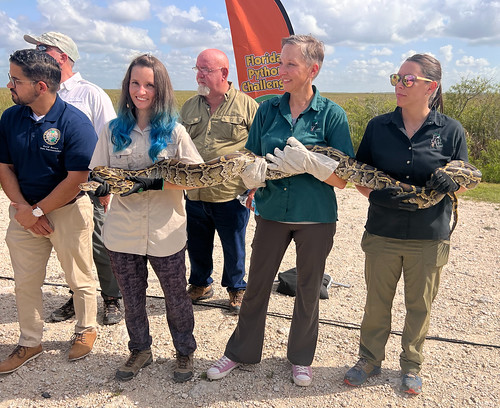Key Points:
- Burmese pythons are not native to Florida. It’s believed that the first Burmese pythons in Florida were released or escaped pets.
- Rabbits, raccoons, foxes, opossums, and bobcats are at the highest risk of being preyed on by pythons in Florida swamps.
- 39 native species of plants and animals that occur in the Everglades National Park are listed, or are candidates under the Endangered Species Act of 1983 (ESA). Some are threatened directly by being eaten or killed by Burmese pythons.
The 2022 Florida Python Challenge started on Friday, August 5 attracting 800+ snake hunters, (is that considered a hobby or a sport?). The 10-day challenge is organized by the Florida Fish and Wildlife Conservation Commission and has been an annual event since 2013. But why would a conservation group be organizing an event to kill pythons? Find out why 800 hunters are diving into Florida swamps to hunt pythons!
Are there really pythons in Florida?
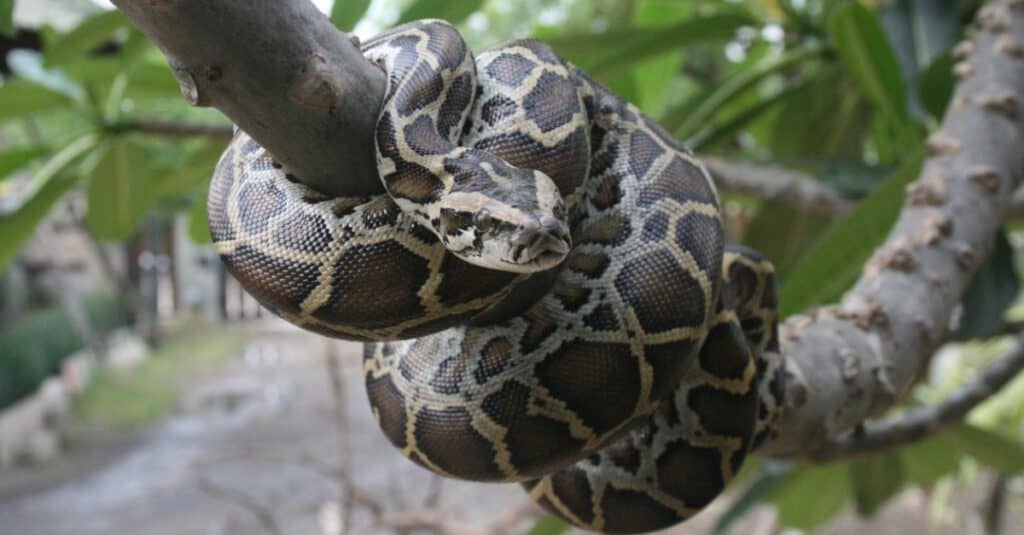
The
Burmese
python is able to swallow animals as large as a deer.
©iStock.com/Lunatic_67
Burmese pythons are huge, heavy bodied snakes that are usually found in the jungles and marshes of southeast Asia. Burmese pythons can be found in India, Vietnam and China, but there is also a large population in Florida. So if you were to go hiking in the Everglades in southern Florida you could come across a 15-foot, 100-pound snake the thickness of a telephone pole!
How did giant Burmese Pythons get into Florida?
The Burmese python is a popular pet with some snake enthusiasts. It is believed that the first Burmese Pythons in Florida were released or escaped pets. Due to the fact that they have very few predators and they can reproduce quickly (they average 20-50 eggs each season, but can have even more!), they were able create a new population in Florida quickly. It is difficult to get an accurate count due to the denseness of the Everglades, but it is thought there are more than 100,000 Burmese pythons in Florida now.
So why are 800 hunters diving into Florida swamps to hunt pythons?
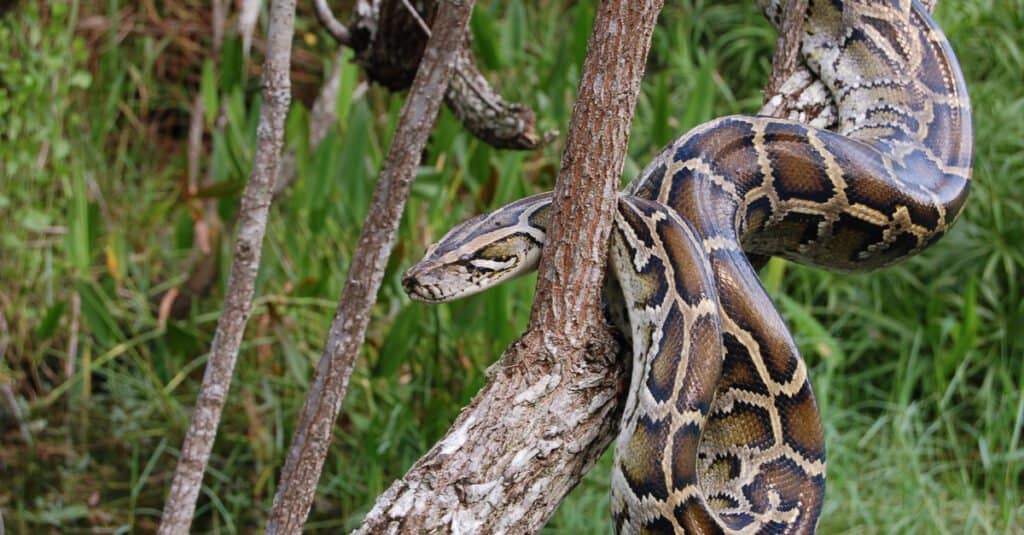
The exotic pet trade can be blamed for the invasion of the Burmese Python in the United States.
©Heiko Kiera/Shutterstock.com
The problem with Burmese pythons living in Florida is that they are an invasive species. They are taking over the ecosystem and eliminating some species, including some endangered species. Think about the ripple effect if certain species are eliminated. If the small mammals, birds and reptiles are all killed and eaten by Burmese pythons, what are the alligators going to eat. They will have to move out of the Everglades and could start to encroach more on areas heavily populated with people like the suburbs of Miami and Fort Lauderdale.
Reproduction and Lifespan of the Burmese Python?
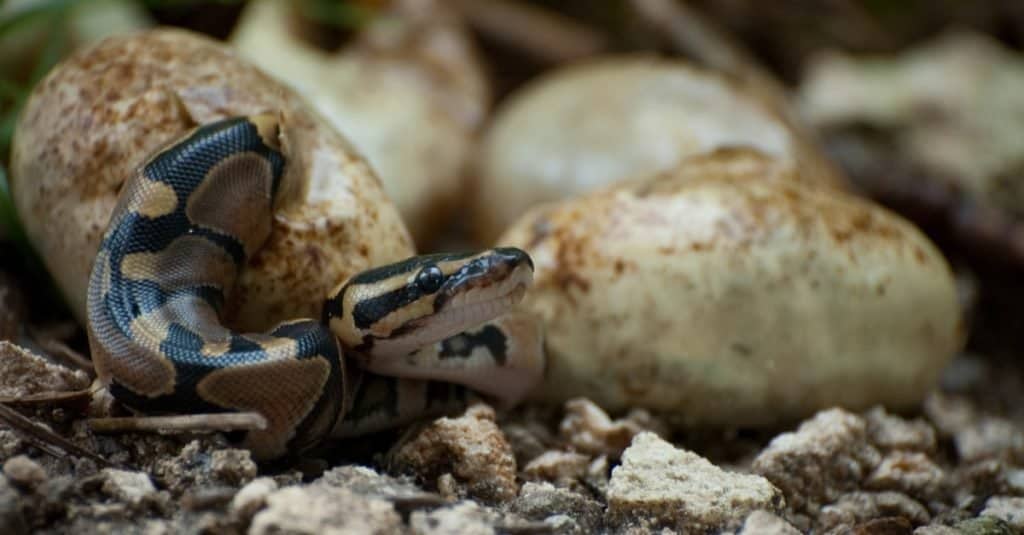
Female Burmese pythons can lay clutches of up to 100 eggs.
©Heiko Kiera/Shutterstock.com
Perhaps one of the most unique characteristics that scientists have discovered about this animal is that these pythons can, unlike most reptiles, reproduce via parthenogenesis (i.e., asexually). Isolated females in captivity without any contact with the male Burmese pythons can still produce viable eggs. After genetic analysis, researchers ultimately found that the hatchlings produced from this type of reproduction were genetically identical to their mothers.
Female Burmese pythons can lay clutches of up to 100 eggs, incubating them for up to three months before the hatchlings emerge.
The typical lifespan of these snakes is about 20 years. Given that they can reproduce via parthenogenesis, and lay so many eggs in one clutch, it’s no wonder that they have multiplied quickly to reach their invasive status in the wilds of Florida’s swamps.
What animals are most at risk from Burmese pythons?
According to a research study or mammal populations in the Everglades published in the Proceedings of the National Academy of Sciences (PNAS), there was a strong correlation between the increase in Burmese Python numbers and decreasein sightings of many small mammal populations. Researchers maintain annual roadkill studies, counting the number and species found on the side of the road as a gauge of populations. Between 2003-2001 here are the animals that are either gone or almost gone from the Everglades:
- Rabbits: 0, there were no rabbits found in the road surveys
- Foxes: 0, also completely absent
- Raccoons: decreased observations by 99.3 %
- Opossums: decreased observations by 98.9%
- Bobcats: decreased observations by 87.5%
What endangered animals are at risk?
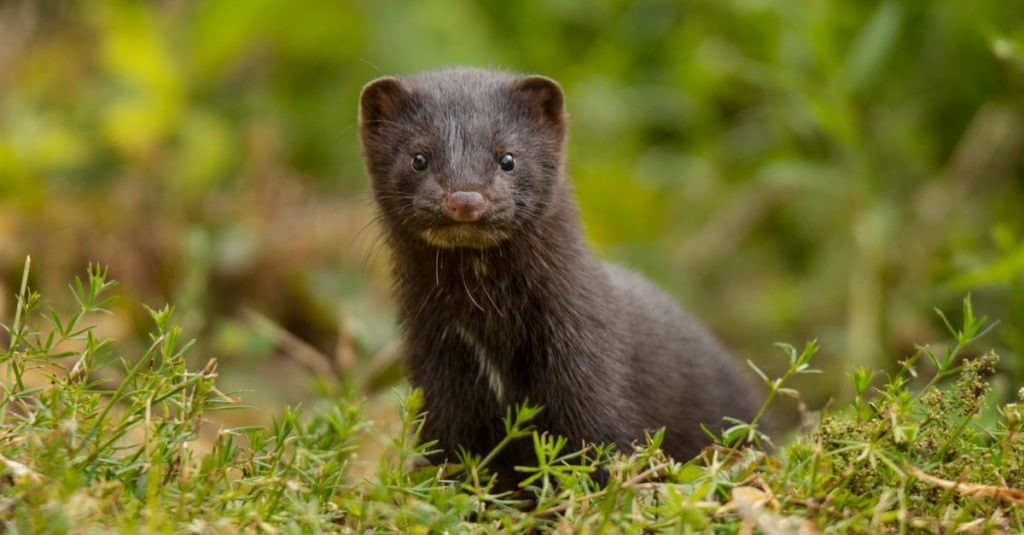
Mink are just one animal that are threatened because of the Burmese pythons
©An inspiration/Shutterstock.com
There are 39 native species of plants and animals that occur in the Everglades National Park that are listed, or are candidates under the Endangered Species Act of 1983 (ESA). Some are threatened directly by being eaten or killed by Burmese pythons and others are affected further down the food chain. Some of the endangered animals of concern are:
Federally-designated endangered:
Florida-designated threatened:
- Barbour’s map turtle
- Florida brown snake
- Gopher tortoise
- Little blue heron
- Big Cypress fox squirrel
- Everglades mink
What happens at Florida’s Python Challenge?
Photo: Florida Department of Fish and Wildlife
Every year in August Florida holds a competition to see how many Burmese pythons can be removed in a 10-day period. Snake hunters from all over the country (some amateur, some professionals) come to the Everglades area to participate in the hunt. There are prizes for the most caught, and the biggest in both the amateur and professional category. In 2020 there were 80 pythons caught, in 2021 there were 223! Last year they had more than 600 hunters and this year, as of early August, there were 850 people registered. Can you imagine how many more pythons they can catch this year?
Who won the Python Challenge last year?
Last year the overall winner was a retired cop (that is one way to protect and serve)! Charles Dachton, of Southwest Ranches collected 41 pythons! For a 10-day competition that averages around 4 every day (or you could use his strategy of catching newly hatched baby pythons, a bunch at a time!) In 2020 the winner “only” caught 8. Maybe it was the additional incentive of a $10,000 prize last year. The Florida Fish and Wildlife Conservation Commission Offers prize money in the range of $1,000 -$2,500 for top winners in both the amateur and professional division but a private sponsor last year donated the additional $10,000 prize.
Donna Kalil won in the professional division with 19 pythons to collect the $2,500 prize. She works for the South Florida Water Management District’s Python Elimination Program.
Is there a $10,000 prize this year?

There is an additional $10,000 prize this year donated by Board Member “Alligator” Ron Bergeron!
©Thomas Barrat/Shutterstock.com
Yes! A huge thanks to South Florida Water Management District Board Member “Alligator” Ron Bergeron for donating the $10,000 for the additional prize incentive.
Where is the competition taking place?
For your python to count in the competition it must be caught from one of the following locations:
- Big Cypress Wildlife Management Area (WMA)
- Everglades and Francis S Taylor WMA
- Frog Pond Public Small Game Hunting Area
- Holey Land WMA
- Rocky Glades Public Small Game Hunting Area
- Rotenberger WMA
- Souther Glades WEA
How big was the biggest Burmese python caught during last years competition?
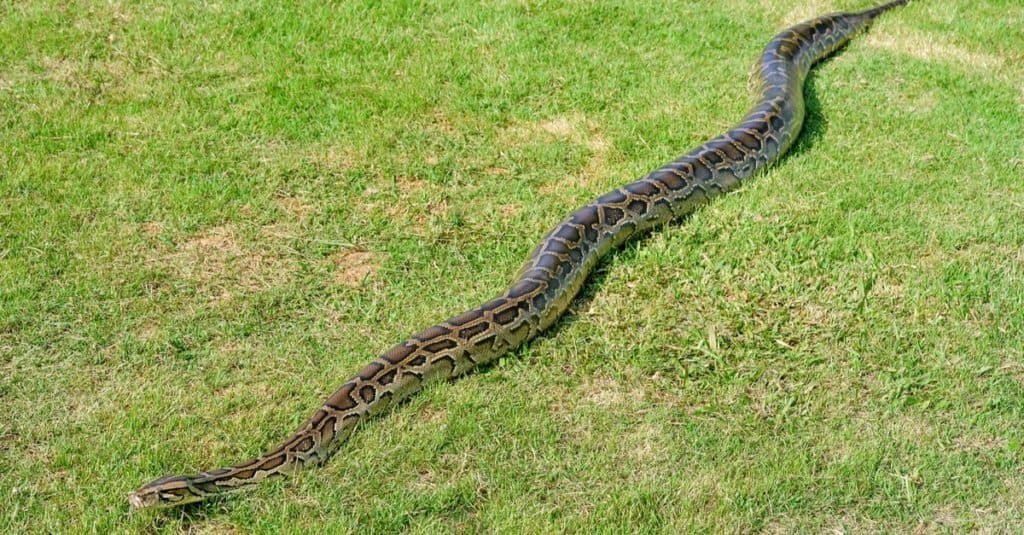
Burmese Pythons can get to be 20 feet long, but most in Florida are closer to 8-10. Last year a 15-foot 9-inch python was caught.
©Yatra/Shutterstock.com
Last year the biggest python was 15-feet 9-inches caught be a novice snake hunter. Get this, the winner was a science teacher from the Florida School for the Deaf and Blind. Teacher Brandon Call was participating in the contest to teach his students about protecting the ecosystem. Nice catch!
Do you want to participate in Florida’s Python Challenge?
Check out the website for official rules and regulations but you don’t need a hunting permit to hunt pythons in Florida. For the competition you do need to take an online training, understand the rules for hunting register online by paying the $25 fee. Plan ahead for next August so you can be one of the 800 hunters diving into Florida swamps to hunt pythons!
Up Next
- Discover 3 Invasive Snakes In Florida
- Discover The Largest Snake In Florida
- The Largest Snake In The US
The photo featured at the top of this post is © iStock.com/Lunatic_67
Discover the "Monster" Snake 5X Bigger than an Anaconda
Every day A-Z Animals sends out some of the most incredible facts in the world from our free newsletter. Want to discover the 10 most beautiful snakes in the world, a "snake island" where you're never more than 3 feet from danger, or a "monster" snake 5X larger than an anaconda? Then sign up right now and you'll start receiving our daily newsletter absolutely free.
Thank you for reading! Have some feedback for us? Contact the AZ Animals editorial team.



